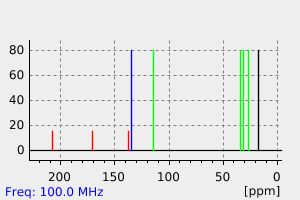3-甲基-2-(-2-丙烯基)环戊烯-1-酮 | 3569-36-6
-
物化性质
-
计算性质
-
ADMET
-
安全信息
-
SDS
-
制备方法与用途
-
上下游信息
-
文献信息
-
表征谱图
-
同类化合物
-
相关功能分类
-
相关结构分类
物化性质
-
沸点:80-86 °C(Press: 3 Torr)
-
密度:0.948±0.06 g/cm3(Predicted)
计算性质
-
辛醇/水分配系数(LogP):1.5
-
重原子数:10
-
可旋转键数:2
-
环数:1.0
-
sp3杂化的碳原子比例:0.44
-
拓扑面积:17.1
-
氢给体数:0
-
氢受体数:1
SDS
上下游信息
-
上游原料
中文名称 英文名称 CAS号 化学式 分子量 —— 3-(but-3-en-1-yl)cyclopent-2-en-1-one 79191-35-8 C9H12O 136.194 2-丙烯基-3-甲基-4-羟基-2-环戊烯-1-酮 allethrolone 29605-88-7 C9H12O2 152.193 -
下游产品
中文名称 英文名称 CAS号 化学式 分子量 —— 2-Cyclopropyl-3-methyl-cyclopent-2-enone 58729-23-0 C9H12O 136.194
反应信息
-
作为反应物:描述:参考文献:名称:2-(丙-2-烯基)环戊-2-烯酮的光化学摘要:已经研究了几种取代的2-(丙-2-烯基)环戊-2-烯酮的光化学。2-(丙-2-烯基)环戊-2-烯酮(2a; R = OMe或OAc),(6a)和(21)进行二-π-甲烷重排为乙烯基环丙烷[[3a和b),( 7)和(29)],而侧链取代的类似物(2b; R = OMe或OAc),(2c; R = OAc)和(6b)在相似条件下进行Z – E异构化。用(2a; R = OAc)进行的敏化和淬灭实验表明(3)源自(2a)的三重激发态。在(2a),(6a)和(21)以及(2b),(2c)和(6b)之间的反应性差异是基于在(分子的侧链。DOI:10.1039/p19760000249
-
作为产物:描述:参考文献:名称:Liu, Zhu-Jin; Rong, Guo-Bin, Synthetic Communications, 1986, vol. 16, # 8, p. 871 - 876摘要:DOI:
文献信息
-
Abnormal Nazarov Reaction. A New Synthetic Approach to 2,3-Disubstituted 2-Cyclopentenones作者:Shigeo Hirano、Seiji Takagi、Tamejiro Hiyama、Hitosi NozakiDOI:10.1246/bcsj.53.169日期:1980.1Acid-catalyzed reaction of β,β′-disubstituted cross conjugated dienones or the corresponding ethylene acetals gives mainly 2,3-disubstituted 2-cyclopentenones in stead of the simple Nazarov cyclization products, 3,4-disubstituted 2-cyclopentenones. This transformation is explained in terms of electrocyclic ring-closure, addition of hydroxylic solvent(s), tautomerization of the resulting 2-hydroxycyclopentanone
-
Process for preparing oxocyclopentene derivatives申请人:Sumitomo Chemical Company, Limited公开号:US04970345A1公开(公告)日:1990-11-13A process for preparing oxocyclopentenes of the formula: ##STR1## wherein R.sup.1 is hydrogen, lower alkyl or lower alkenyl and R.sup.2 is hydrogen, lower alkyl, lower alkenyl, lower alkynyl, substituted or unsubstituted aryl, ar(lower)alkyl, thienyl or cycloalkyl, which comprises subjecting a furan-carbinol of the formula: ##STR2## wherein R.sup.1 is as defined above and R.sup.3 is hydrogen, lower alkyl, lower alkenyl, lower alkynyl, substituted or unsubstituted aryl, ar(lower)alkyl, thienyl or cycloalkyl to rearrangement, subjecting the resultant hydroxycyclopentenone of the formula: ##STR3## wherein R.sup.1 and R.sup.3 are each as defined above to hydrogenation and subjecting the resulting hydroxycyclopentanone of the formula; ##STR4## wherein R.sup.1 and R.sup.2 are each as defined above to dehydration.
-
Synthesis of mono- and 1,4-dicarbonyl compounds based on the oxygenation of phosphonate carbanions. Synthesis of dihydrojasmone, allethrone and methylenomycin b作者:Marian Mikołajczyk、Wanda Midura、Sławomir GrzejszczakDOI:10.1016/s0040-4039(01)81212-0日期:1984.1Oxidation of the α-alkylthio-substituted phosphonate carbanions was found to give the corresponding carbonyl compounds. A new synthesis of 1,4-dicarbonyl systems involving the oxygenation of phosphonate carbanions as a key step is described. Total synthesis of dihydrojasmone and allethrone and formal synthesis of methylenomycin B is reported.
-
Reaction of β-halo α, β-unsaturated ketones with cuprate reagents. Efficient syntheses of β, β-dialkyl ketones and β-alkyl α,β-unsaturated ketones. A synthesis of (<i>Z</i>)-jasmone作者:Edward Piers、Kin Fai Cheng、Isao NagakuraDOI:10.1139/v82-185日期:1982.5.15
Treatment of the 3-halo-2-cyclohexen-1-ones 11–15 and 17 with an excess of lithium dimethylcuprate provided good to excellent yields of the corresponding 3,3-dimethylcyclohexanones 21–24. Similar reactions involving the β-bromo cyclopentenones 19 and 20 stopped at the monoaddition stage, producing the cyclopentenones 40 and 43. Reaction of the β-bromo cyclohexenones 12 and 15 with 1.1 equiv. of lithium dimethylcuprate did not effect clean conversion of these substrates into the corresponding 3-methyl-2-cyclohexen-1-ones. When a series of β-bromo enones 12, 14–19 were allowed to react with the lithium (phenylthio)(alkyl)cuprates 44–47, the corresponding β-alkyl enones were, in general, produced cleanly and efficiently. However, reaction of 3-bromo-2-methyl-2-cyclopenten-1-one (19) with the cuprate reagent 44 gave mainly the β-phenylthio enone 49. This undesired result could be avoided by employing, in the place of 19, the β-iodo cyclopentenone 50, which reacted smoothly with 44 to give a high yield of 2,3-dimefhyl-2-cyclopenten-1-one (40). Reaction of 3-bromo-2-cyclohexen-1-one (14) with 3 equiv. of the mixed vinylcuprate reagent 48 gave 3-(3-butenyl)-2-cyclohexen-1-one (32). Alkylation of 1,3-cyclopentanedione with (Z)-1-chloro-2-pentene afforded compound 51, which was converted into the β-bromo enone 52. Treatment of the latter substance with lithium dimethylcuprate provided (Z)-jasmone (53).
将3-卤代-2-环己烯-1-酮11-15和17与过量的二甲基溴化锂处理,得到相应的3,3-二甲基环己酮21-24,收率良好至优良。涉及β-溴代环戊烯酮19和20的类似反应在单加成阶段停止,产生环戊烯酮40和43。β-溴代环己烯酮12和15与1.1当量的二甲基溴化锂反应未对这些底物进行干净转化为相应的3-甲基-2-环己烯-1-酮产生影响。当一系列β-溴代烯酮12、14-19与苯基硫代烷基铜盐44-47反应时,通常产生相应的β-烷基烯酮,而且效率高。然而,3-溴代-2-甲基-2-环戊烯-1-酮(19)与铜盐试剂44反应主要产生β-苯基硫代烯酮49。通过使用β-碘代环戊烯酮50代替19,可以避免这种不良结果,后者与44反应顺利,产生高收率的2,3-二甲基-2-环戊烯-1-酮(40)。3-溴代-2-环己烯-1-酮(14)与混合乙烯铜盐试剂48的3当量反应产生3-(3-丁烯基)-2-环己烯-1-酮(32)。1,3-环戊二酮与(Z)-1-氯-2-戊烯烷基化生成化合物51,进一步转化为β-溴代烯酮52。后一物质经二甲基溴化锂处理得到(Z)-茉莉酮(53)。 -
Synthesis of Pyrethroids and Jasmonoids through Palladium-Catalyzed Cross-Coupling Reactions作者:Viviana Heguaburu、Florencia Parpal、Ana Paula Paullier、Enrique PandolfiDOI:10.1055/a-1736-1749日期:2022.6The synthesis of jasmone and related jasmonoids and pyrethroids is described. These compounds play a defensive role in plants and share a common cyclopentenone core with variations in the side chains. Jasmone, cinerone, allylrethrone, and derivatives were synthesized through π-allyl palladium cross-coupling of stannane derivatives. With selective hydrogenation, dihydrojasmone, and dihydrocinerone were
表征谱图
-
氢谱1HNMR
-
质谱MS
-
碳谱13CNMR
-
红外IR
-
拉曼Raman
-
峰位数据
-
峰位匹配
-
表征信息







